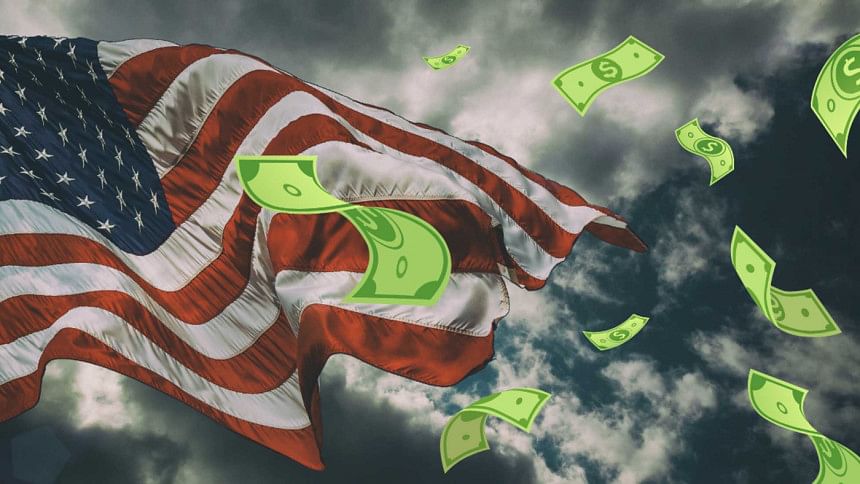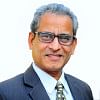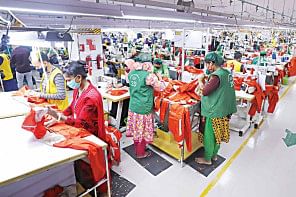What message does the US economy send to the world?

The US economy has begun to display a bizarre combination of conflicting signals, making global recovery largely unpredictable. This wasn't the case even a few months ago, when inflation didn't rear its ugly head. Most messages were pleasant and encouraging for its trade and financial partners across the globe.
GDP growth in the US in 2021 was 5.7 percent—never seen in four decades. It was the strongest calendar-year growth since a 7.2 percent surge in 1984 following a previous recession. But the recent inflation of 8.5 percent—never seen in four decades—has posed serious threats not only to the US economy, but also to other developing partners that are connected to it via trade, services, remittance, investment, and capital flows.
Another happy event for the US economy was its impressive unemployment rate, which reached its pre-pandemic level of 3.6 percent in early 2022. The unemployment rate was 4.4 percent in March 2007—just before the Great Recession of 2007-09. During the financial crisis, which coincided with the recession, unemployment reached a new high of 10 percent. The rate took 10 years to come down to 4.4 percent in 2017.
In contrast, the recent unemployment rate took only two years to reach 3.6 percent, signalling one of the fastest recoveries in the labour market in US history. The rate is so impressive that it's far below the long-term natural rate of American unemployment—five percent.
Recently, Jeromy Powell, chair of the Federal Reserve, the central banking system of the US, told the press that roughly 17 jobs were waiting for 10 jobseekers, signalling a tight labour market. Signs saying "We're hiring," "Help wanted," "Positions vacant," and the like are visible everywhere. The Fed chair is justifying a 25 basis point (=0.25 percent) hike in the central bank's policy rate to tame the crazily rising inflation. The Fed funds rate has now touched 0.5 percent after the hike, which is still lower than that of 2.5 percent in the pre-pandemic era. Powell assures that this monetary tightening won't lower the GDP growth much, and unemployment may not break the ceiling of its natural rate of five percent.
The question may arise that if 17 positions remain open against 10 jobseekers, why the unemployment rate still hovers over 3.6 percent. Shouldn't it be zero? No, because there will always remain an irreducible amount of unemployment, which Milton Friedman termed as the non-trade-off rate of unemployment. When the labour market is tight, jobseekers tend to switch jobs in quest of higher job satisfaction and more handsome salaries. Thus, some job candidates will remain unemployed for a certain period—which we call frictional unemployment.
In addition, structural unemployment will keep some people jobless because of changes in company structure, technology, and job types. Workers at a printing press may lose their jobs because the company is moving fully online. Typists in different offices may lose their jobs because their organisations are modernising their operations and demanding computer keyboard specialists. During the coronavirus recession, many companies moved their operations online; many universities graduated their curricula to screen-based digital settings. So, those without proper training will remain jobless, even though there are new openings. There are other types of unemployment: seasonal and cyclical. Thus, these four types of unemployment will keep a minimum level of joblessness in the economy, no matter how well the country is navigating its route.
Going below the current unemployment level in the US is neither desirable nor feasible for the country. But this happy news is marred by highly hot inflation that has thrown cold waters in all gains of the recovery. People have jobs, wallets are healthy with dollar notes or plastic cards, but buyers feel the heat whenever they go shopping or to fill up their gasoline tanks.
This high inflation will be transmitted to other economies that have connections with the US through the channels of trade, remittance, services, and investments. For example, Bangladesh suffered from the highest rate of inflation in the 1970s when the US was weathering through the Great Inflation. During the current recovery, Bangladesh's imports are rising at a rate much faster than that of exports. US inflation will penetrate Bangladesh mainly through imports.
As the International Monetary Fund (IMF) forecasts, the US GDP growth will come down from 5.7 percent in 2021 to four percent in 2022. Still, this is higher than the country's long-run growth, which is slightly over two percent. Hence, the Fed's step to tighten the economy with an objective to bring inflation down from a super high of 8.5 percent is justified. The Fed is expected to raise the policy rate by another 50 basis points in early May. Otherwise, inflation can't be controlled.
The long-term inflation target for the US economy is two percent—much lower than the usual target of four to five percent in developing economies. Hence, bringing inflation down from 8.5 percent to two percent is hard for its central bank, unless it becomes desperate in raising the policy rate up to, say, four to five percent from the current rate of 0.5 percent. But this must be done step by step to avoid a sudden choking of businesses.
The policy-rate hike alone won't control this inflation too effectively because of the multiple sources of current inflation. Central banks are helpless when inflation is coming largely from supply shocks. And this is true for the US inflation, which can largely be attributed to supply-chain disruptions due to Covid and Russia's war on Ukraine. Due to the tight labour market, wages are rising faster, driving up the cost-push side of inflation—which is hard to control simply by an increase in the interest rate of the Fed's monetary policy. The world must be on alert on both how the US handles price spirals and how it fails to control a large part of its stubborn inflation. The ghost of the early 1980s seems to be looming on the horizon.
Dr Birupaksha Paul is a professor of economics at the State University of New York at Cortland in the US and former chief economist of Bangladesh Bank.

 For all latest news, follow The Daily Star's Google News channel.
For all latest news, follow The Daily Star's Google News channel. 



Comments